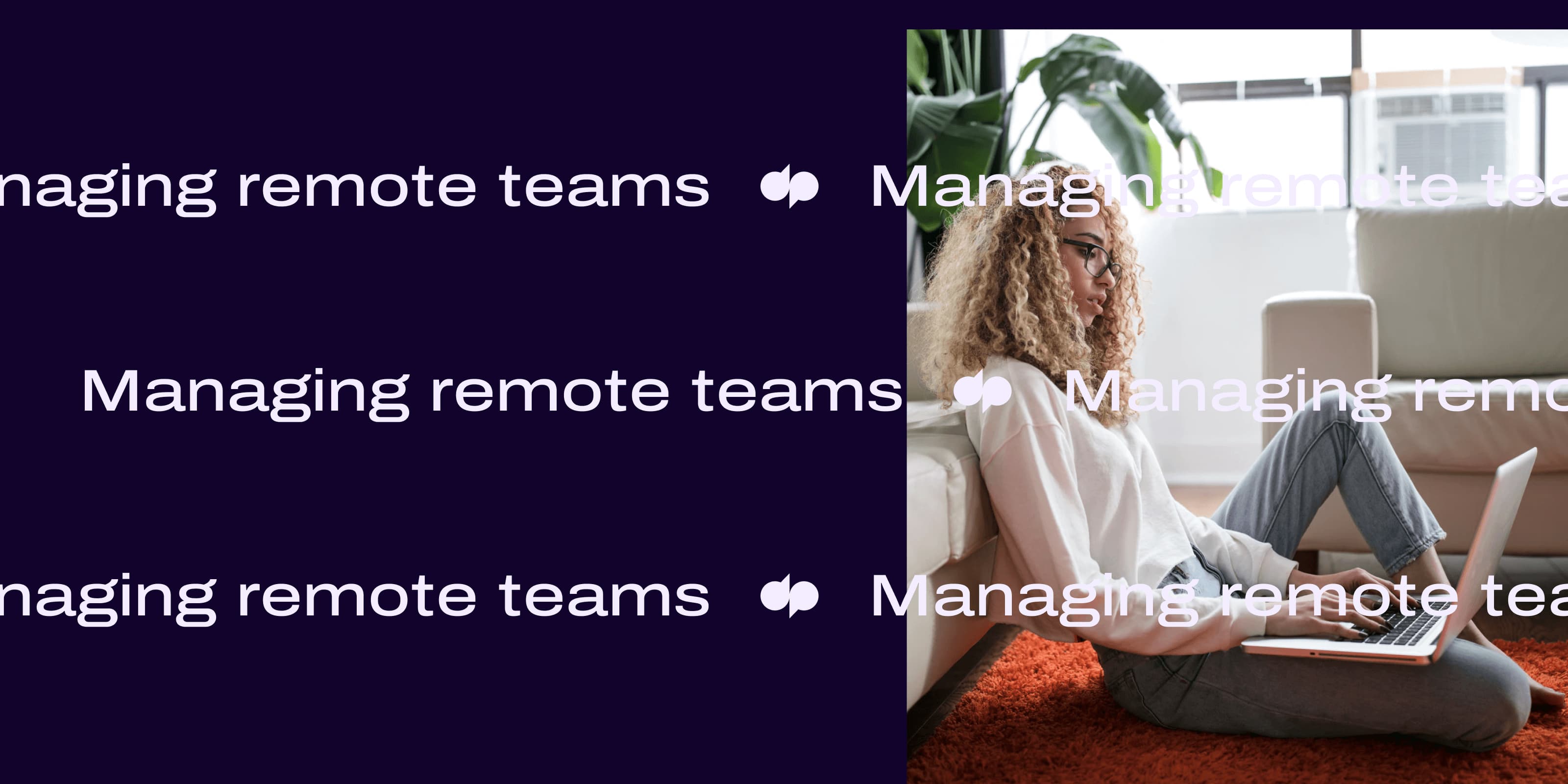The ultimate manager’s guide to managing remote teams: 12 tips

VP of Customer Experience

Tags
Share
More and more companies today are building out their remote teams, and pandemic or not, remote work is growing among companies that have physical offices as well. We at Dialpad have a pretty big remote team too!
The thing is, remote work doesn’t exactly come with a brand new set of management challenges. In fact, many of the same principles as managing an in-office team still hold true. It’s more so the fact that certain issues get… exacerbated, shall we say?
If you’re managing remote employees, keep reading. I'll go through 12 tips for how to keep remote workers productive—and happy.
12 tips for managing a remote team
1. Create clear communication guidelines
If you’re working remotely, it’s easy to let communication fall by the wayside and let your team operate pretty independently. However, that’s exactly what you want to steer clear of. You must work to create that virtual team presence where all feel comfortable. “If you, the manager, don’t create good, open communication channels, the remote worker will feel, well, ‘remote’ and forgotten,” says INSEAD associate professor Mark Mortensen.
This can get complicated in larger companies, where some teams are remote and others aren’t, or there are multiple remote teams working separately. “As a manager, it’s important to keep the flow of information about what’s happening individually, on a team, and in the company transparent and available for everyone to see,” notes Trello VP of Marketing Stella Garber.
Your communication guidelines should be shared with new hires as part of their onboarding process, and can include things like:
How the team prefers to communicate (email vs. text message vs. chat vs. phone vs. video conferencing—which communication tool will it be?) We use Dialpad because it lets us communicate through voice calls, video meetings, and also instant messaging:

When the team prefers to communicate (regular meetings, certain days or times—don’t forget to adjust for time zones!)
Expected email (or other communication) turnaround time
Information on heads-down days, if your company does them
How employees can let the team know when they’re working remotely if it’s not their permanent set up
2. Educate yourself on the struggles of remote management
Knowing the potential challenges you’re likely to face when managing a remote or hybrid work force means you can better equip yourself to deal with them quickly and efficiently.
You need to know how to maintain employee engagement—no matter where they’re located. There are a few primary issues you may want to consider right at the start.
Loss of direct supervision
There can be scenarios where managers feel they can’t fully trust remote workers.
In a physical environment, relationships are more easily established and maintained, but some managers struggle to achieve this when staff are working from home. If you micromanage, these are issues you may not overcome without changing your own management style.
There are some things you can do or implement that can help with managing remotely:
As a manager, your goal is to build trust within your team. When you have trust, your teamfeels comfortable taking risks, speaking their minds, and coming up with fresh ideas in theirwork.
Use team building exercises to help build a sense of "team" and camaraderie. We use Dialpad’s video conferencing to host these exercises. For example: virtual pet hour-introduce your fur babies to the team, or reptiles or whatever you love!
Only set precise deadlines where needed. Accept that a remote worker’s schedule may differ but that they will still get work done. Allowing your team the autonomy to work when it suits them best, has proven to show greater quality and productivity. Truly helping to foster work life balance.
Have informal check-ins at least once per week. These can be both team chats and one on one. We do both, we have team huddles where it's conversational and more focused on humanity, we have team meetings and 1:1’s. One of our leaders has her team take turns asking fun questions: Example-In middle school what was your favorite after school snack? (Alternatively, you could run regular check ins using a sprint planning tool to keep things organized.)
Set up a weekly or monthly reporting system so you still have oversight on task/project progress.
👉 Dialpad tip:
If your team can’t get together in a physical workspace, implement fun games and exercises that they can all participate in. It helps them retain a feeling of team and is also great for morale.
Information accessibility
Company and customer data and information are valuable currencies to your business. And many of your workers need to access that information to do their jobs properly. But you have to have some focus on cybersecurity, so that they can both access and communicate information securely.
Ensure you have the necessary remote security policies in place.
Make sure your networks are secure.
Have regulations for use of personal devices (like a good BYOD policy).
Make sure your IT team can provide all needed support. *Dialpad can help connect your IT to your team members… Ask us how!
Educate remote workers on risks like malware or phishing attack.
Employee isolation
If you’ve moved to a remote working model, even if only temporarily, then isolation may be a real challenge for many people on your team.
As a manager, you have a responsibility not only to ensure work is being done, but also that your workers have support and tools to help prevent or reduce any feelings of isolation and to maintain a work-life balance.
Make sure remote workers have a strong connection to the main office/location
Ensure remote workers are recognized and appreciated
Virtual shoutouts go a long way! They light up chat channels, and company meetings! For example, our team gives each other virtual stickers every week to thank each other for helping out and being awesome in general:

Use good collaboration tools so workers are connected
Collaboration is key!!!
Review connections to see if any workers are being “left out”
Create a remote culture where those who are not comfortable on video can still participate
👉Dialpad tip:
Hold weekly team meetings to establish communication and good social interaction. And, as a manager, hold regular one-on-one supervision sessions so workers can flag any issues.
Unseen distractions and interruptions
If you’re working from home, there are many potential distractions that can interrupt your workflow. Children running about, pets making noise, people coming to the door...
While this is perhaps more about self-management, you as a manager can still suggest various methods of avoiding some of those interruptions.
Schedule
. While it’s harder for a manager to “control” a remote worker’s day, suggest that they schedule their day with breaks, personal comms time, getting fresh air, etc.
Having company wide-virtual coffee chats, hydration nation trackers (H2O), virtual walks outside.. These things can bring people together, spark conversation and engagement and help really drive the value of humanity first.
Goals
. Setting goals enables a worker to focus on the most important tasks.
Focus on the outcomes, not the path there. This allows your teams to truly grow.
Boundaries
: Establishing boundaries with family members and others can help team members concentrate on work.
In my home, we rotate on home responsibilities, and each has signs for when we are working. Mine says “In session, please take a number” where my partner says “On-Air” and turns red when it’s critical do-not-disturb time!
Windows. It can be too easy to jump on Facebook to see what the latest gossip with Bob and Marcie is. Keep all non-work windows closed except during any downtime.
👀 Interested in tips on managing a remote or hybrid team?
Grab the Hybrid Work Playbook, which includes real-life case studies and breaks down all things hybrid + remote, from building and sustaining a hybrid workforce to equipping your team for success.
Lack of holistic communication due to loss of non-verbal communication
You may think that communication is an issue easily solved with the various tech-based solutions you’re using. But you've probably seen no shortage of research that suggests that most of our communication is non-verbal. So, you need to find ways to compensate for the loss of the non-verbal part of communication.
Video calls
. Face-to-face video conferencing is a great way to retain non-verbal comms. If your team is particularly large, consider breaking it down into sections for the regular calls.
Be mindful that video fatigue exists, and you may need to allow for camera downtime. In fact, our research found that 82.9% believe that not all video meetings require video.
Rules
. Video conferencing presents its own challenges. Establish rules about who talks when.
I have in the past mailed talking sticks to my teams to act as a visual cue for who’s talking next.
Reserve
. Try to reserve email and text-based comms for information that doesn’t have a non-verbal aspect.
We keep email for the items we need to track and chats for quick decision making.
Learn. Every person has their own preferences for how they absorb new information. If you can, take this into consideration when you're doing training and development with your team.
👉 Dialpad tip:
Treat any virtual meetings as if they were in-person meetings. Have an agenda and a dress code (if that's what's usual for you). It’s fine to have informal chats before the meeting starts (and after it ends) but establish some ground rules.
3. Figure out and delegate responsibilities
Whether manager of the entire company or of just one team or department, one of your primary duties is to delegate work and tasks. That still holds true, perhaps more so, if you are managing remote workers.
Identify the work. Have a good understanding of what needs done, whether a single project or a series of ongoing tasks.
Breakdown. Break any work into smaller tasks or jobs to make it easier.
Goals. Set clear expectations as to what constitutes a completed task.
Identify the team members. Who is best suited to which tasks?
Software. Use a good task management or project management system so everyone knows where they are and what they have to do.
Discuss. Discuss everything with your team. Signpost them to resources or information they may need. Also discuss your expectations and get agreement from them.
Communicate. Set a schedule for regular conference calls on progress or problems. This also includes individuals being able to contact you if needed.
Monitoring. Put a system in place where it is easy to generate reports and see analytics on how things are working.
Incentives. If you have deadlines, why not incentivize the work? You can make it competitive but fun.
4. Make precise standards for remote work productivity
Remote workers may choose different schedules for how they work from home—not to slack, but to fit when they’re most productive during the day.
Because everyone’s so different, having some set standards to zoom in on and measure productivity can be useful.
Set timeframes. These could be daily, weekly, or monthly. It shouldn’t matter what times your team chooses to work (unless, for example, they are offering customer support). It also shouldn’t matter in which time zone they are.
Define KPIs. For example, you may want a content writer to submit a certain word count every week.
Set milestones for tasks or for overall projects. Bigger tasks can especially benefit from this as it not only makes things easier but can also help you collect data for future planning.
Consider using workforce analytics tools to monitor productivity. For example,
consider tools and other employee monitoring software that can help track computer
activities, analyze productivity, and identify potential security risks.
5. Make sure the right tools are available and accessible
If your team members are working remotely, then often they don’t have access to the same tool kits they would in their normal work environment. What tools they need will vary according to your industry and their responsibilities.
You may use tools such as Dropbox, Asana, or Microsoft Teams—but one general thing most remote teams will need is a good unified communications and collaboration platform like Dialpad.
6. Be sensitive to overworking and overloading
This is about both good management and good self-management.
As a manager, you should be careful not to assign too much work or to impose too tight deadlines. Be open to discussion with your remote team. If they feel like they’re under too much pressure and be prepared to adjust work to make things (a little) easier for them.
As a remote worker, there are some things you can do:
Set time limits on how long you work without a break.
I advise my organization to proactively block times on their calendars, and hold themselves accountable. A few have “Get up and move blocks.”
Avoid your work-life boundaries blurring. Have a clear separation of work and “play.”
We apply a people first approach—before we are Dialers, we are humans.
Take regular exercise. This could be as simple as taking the dog for a walk twice a day (if no dog, why not borrow one?)
We have company wide virtual options, boot camp, and yoga. We are working hard to live up to our values!
7. Create a virtual water cooler
Doing regular team meetings is a good call for managing remote employees, but it’s not enough. Your team members need to interact with each other spontaneously and independently, and to get to know each other as people, not just co-workers.
Mortenson, in the previously-quoted article, has an interesting idea: Set up video conferencing around the office that’s always on—a virtual water cooler. “It might feel weird the first day it’s on, but by the tenth day, people are more comfortable,” he says, noting that video is especially good for this because it “brings us together and connects us, increasing the intimacy of our relationships with one another.”
(I mentioned this earlier, but we have a “pet cam” channel that just runs on Fridays for half an hour to an hour, where people can drop in with their pets on camera.)
You can also build personal time into meetings, allowing for 5-10 minutes at the beginning or end of meetings for everyone to give a personal update. The big upside of using video conferencing for these ideas is that it naturally leads to more impromptu, unplanned conversations that can often lead to the best ideas from your team members.
8. Gather feedback regularly
If you’re just moving to a remote model for the first time, or even if it is an ongoing process, gathering feedback is essential to make sure that it’s working well for your team.
Feedback helps you identify weak points that need adjusting or even things that aren’t working at all. There are several ways you can do this:
One to ones. If you’re already having virtual meetings with individual workers, use them to ask if they feel current processes work well.
Polls. Anonymous polls or surveys can gather data on different aspects of your working model.
Workshops. If you can have physical workshops, use them to troubleshoot issues with your model. If not, use something like Dialpad's video conferencing feature to hold a virtual workshop.
9. Provide emotional support
You already know that isolation is a problem and that can impact on the psychological well being of your team. So how can you show support?
Don’t wait for people to tell you things. Ask questions, then actively listen. It costs nothing to ask a team member, “How are you coping?” at the end of a business call.
Practice empathy. It’s not enough to hear about any problems, you need to be able to understand them, too.
Focus on values. Even as you begin to work differently, it’s important to keep a focus on any company values. Remind your remote team members of them and use them to both support and inspire.
Create support networks. It can help to deal with personal issues if you can talk and listen to your peers. Set up online meeting groups that are only there to talk or let off steam.
10. Don’t neglect one-on-ones
Team camaraderie is important, but so is making time to talk to your employees one-on-one. This gives your team members the chance to address any issues they might be afraid to bring up in group meetings, or don’t want to discuss via email for fear of being misunderstood.
In addition to being a good time to air issues they might not want to discuss elsewhere, it’s also a great way to check in with team members about their role and if it’s aligning with their overall career goals. (Mentoring does help with employee retention!)
11. Be flexible
It isn't always easy to manage a telecommuting team. With some roles (contact center staff, for example), it may be more difficult to exercise flexibility. But it doesn't mean you have to resort to micromanaging your remote workforce.
For example, if they have a set amount of hours to work in a seven-day period, then, if possible, allow them to structure it in any way that suits them. Flexibility is important for not only employees, but also managers of remote teams too!
12. Get the team together physically once in a while
As we all know, breaking bread together builds stronger teams. However, it’s a little awkward to set up a video conference inside a restaurant. Spending time with your teammates in person every so often is essential.
One idea: If you hire new employees in groups, consider doing training in-person to make them feel welcomed to the team. We pair up new Dialers with a “buddy” (you can do this virtually too—just have them schedule catch-ups with each other in a video call every few days) during their first week to help them get acquainted and settle in. It’s great.
Although doing a team meeting over video might not be exactly the same thing as being in-person, it does enable bonds to form faster during those times when everyone is in one place. When people who work together over video conferencing meet in person for the first time, they’re often amazed at how familiar their co-workers seem. So find ways to bring your remote team face-to-face as often as possible, whether in-person or using video. It’s an easy and effective way to build strong relationships among people who aren’t together every day.
In no time, you’ll be a pro at managing remote employees
You may be worried about shifting to manage your remote teams. But there really isn’t any need to be.
With so many great tools and apps like Dialpad out there to make remote work easier, you’ll find that communication and management are as easy as if your team were in the office with you. From sharing work-related files to just having fun face-to-face interactions and regular phone calls, it is possible to retain many of the best parts of in-office work as a remote workers.
Whether you’re managing a remote team of 10 or an entire company moving to remote or hybrid work, there's a way to make your home office less lonely—while making sure it's just as productive.
Need a better way to manage your remote team using a unified communications platform?
With Dialpad, you can make phone calls, have video meetings, and send instant + SMS/MMS messages, all from a single desktop or mobile app. Try it free for 14 days! Signup takes just a few minutes, and you'll be set up with a virtual business number too. Or, take a self-guided interactive tour of the app first!








